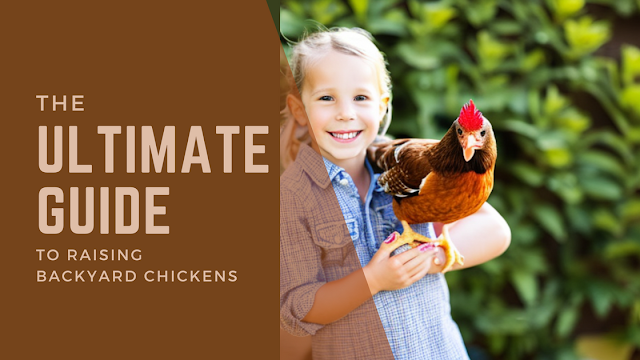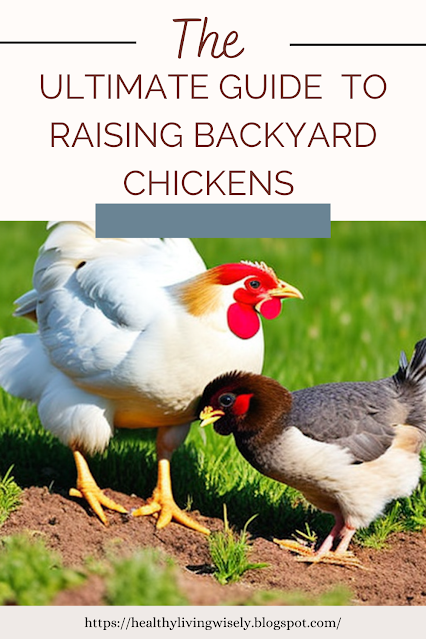The Ultimate Guide to Raising Backyard Chickens: Tips, Tricks, and Everything in Between
Introduction
Keeping chickens in your backyard is an excellent way to get fresh eggs and have a personal connection to your food. Raising backyard chickens is a fun and rewarding experience, but it requires a lot of knowledge and effort. This guide aims to provide you with all the information you need to raise backyard chickens successfully.
Hatching Eggs, Chicks, Started Pullets, or Adult Birds
The first step to raising backyard chickens is to decide which option is best for you. Each choice has its merits, but it depends on your preferences and needs.
Hatching Eggs
Hatching eggs can be a great option if you want to experience the miracle of life and are willing to take on the challenge. Here are some of the advantages and disadvantages of hatching eggs:
Pros
- You can experience the entire hatching process, from incubation to hatching, and be a part of the chick’s life from the beginning.
- It’s usually cheaper than buying chicks or started pullets.
Cons
- It requires more effort, equipment, and knowledge.
- The hatch rate is not guaranteed, and you may end up with fewer chicks than you expected.
Chicks
Buying chicks is the most common way to start your flock. Chicks are readily available, and you can choose from a wide variety of breeds. Here are some of the advantages and disadvantages of buying chicks:
Pros
- It’s the easiest option, as you don’t need any special knowledge or equipment.
- You can raise the chicks as you want and get to know them from a young age.
Cons
- Chicks can be fragile, and you need to take extra care to ensure their survival.
- It can be more expensive than hatching eggs.
Started Pullets
Started pullets are adolescent chickens that are ready to lay eggs soon. This option is suitable for those who don’t want to wait for their chicks to mature or don’t want to deal with the hassle of raising them. Here are some of the advantages and disadvantages of started pullets:
Pros
- You don’t need to wait for them to mature or deal with the hassle of raising them.
- They’re usually sexed, so you know you’re getting females that are ready to lay eggs.
Cons
- Started pullets can be expensive, especially if they’re of a good laying breed.
- You won’t experience the excitement of raising a chick from the beginning.
Adult Birds
Buying adult birds is an option if you want to start with a mature flock that’s already laying eggs. This option is suitable for those who don’t have the time, energy, or desire to raise chicks. Here are some of the advantages and disadvantages of buying adult birds:
Pros
- You can start getting eggs immediately.
- You don’t need to wait for them to mature.
Cons
- It can be more expensive than other options.
- You won’t experience the excitement of raising a chick from the beginning.
Building a Coop
Once you’ve decided on the type of birds you want, the next step is to build a coop. A coop provides a safe and comfortable place for your chickens to live and lay eggs. Here are some essential things to consider when building a coop:
Materials
The materials you use for your coop should be sturdy and durable. Here are some materials you might consider:
- Wood: Wood is the most popular material for coops as it’s natural and attractive. However, it’s essential to choose a rot-resistant wood, such as cedar or redwood, and to treat it to prevent decay.
- Metal: Metal is an excellent option if you want a more durable
Materials for Building a Chicken Coop
When it comes to raising backyard chickens, one of the most important aspects is building a chicken coop that provides shelter and security for your feathered friends. Here are the materials you will need:
- Lumber: You will need a variety of sizes for framing and siding, depending on the size of your coop.
- Nails and Screws: Make sure to have a variety of sizes to accommodate different parts of the coop.
- Chicken Wire or Hardware Cloth: Chicken wire or hardware cloth will be used to cover windows and vents, as well as to enclose the run.
- Roofing Materials: You can use asphalt shingles or metal roofing, depending on your preference.
- Plywood or OSB: Plywood or OSB will be used for sheathing the walls and roof.
- Hinges and Latches: Hinges and latches will be used to secure doors and windows.
- Insulation: Insulation will help to keep your chickens warm during the colder months.
- Paint or Stain: Paint or stain will help to protect the wood from weathering and to add a decorative touch.
With these materials, you can build a chicken coop that will keep your birds happy and healthy. [3]
Here are some additional materials that you might need to get started with woodworking:
- Safety equipment: When working with wood, safety should be your top priority. You’ll need safety glasses or goggles to protect your eyes, as well as earplugs or earmuffs to protect your hearing. You may also want to invest in a dust mask or respirator to protect your lungs from wood dust.
- Measuring tools: Accurate measurements are essential for successful woodworking. A measuring tape, a combination square, and a marking knife are all useful tools to have on hand.
- Cutting tools: There is a variety of cutting tools you might need, depending on your project. A handsaw or circular saw can be useful for rough cuts, while a jigsaw or bandsaw can help you make more precise cuts. You’ll also need a set of chisels for carving and a set of knives for whittling.
- Sanding tools: After cutting your wood, you’ll need to sand it smoothly. A random orb ander is a good tool for general sanding, while a belt sander can help you tackle larger surfaces.
- Clamps: Clamps are essential for holding your wood in place while you work on it. You’ll want a variety of clamps in different sizes and styles.
- Finishing materials: Once your project is complete, you’ll need to apply a finish to protect the wood and enhance its appearance. A clear coat or stain can be applied using a brush or sprayer.
- Woodworking books and magazines: There are a wealth of resources available to help you learn more about woodworking. Books and magazines can provide step-by-step instructions, design inspiration, and tips and techniques for working with different types of wood.
With these materials, you’ll be well on your way to becoming a skilled woodworker.
Of course, there are many more tools and materials you might need depending on your project, but these basics should help you get started.
- Maintaining the Coop
- Cleaning the coop regularly
- Disinfecting the coop occasionally
- Checking for any signs of damage to the coop and repairing it as soon as possible
- Replacing the bedding every few weeks
- Making sure there is enough ventilation in the coop
- Frequently Asked Questions
- Q: How many chickens should I start with?
- A: It’s recommended to start with 3–5 chickens, depending on how much space you have available.
Q: How much does it cost to raise backyard chickens?
A: The initial cost of building a coop and buying chickens can vary, but after that, the cost of feed and other supplies is relatively low. It’s estimated that the cost of feed for one chicken is around $20 for a 50-pound bag.
Q: What do chickens eat?
A: Chickens require a balanced diet of protein, carbohydrates, and other nutrients. Commercially prepared chicken feed is a good option, but they can also eat fruits, vegetables, and grains.
Q: Do chickens need to be vaccinated?
A: Chickens don’t necessarily need to be vaccinated, but it’s recommended to protect them from certain diseases. Talk to your local vet or poultry expert for more information.
Q: How often do chickens lay eggs?
A: Most chickens lay an egg every day or two, but this can vary depending on the breed and age of the chicken.
Conclusion
Raising backyard chickens can be a fun and rewarding experience, but it requires some planning and preparation.
By following the tips and guidelines outlined in this article, you can create a safe and comfortable environment for your chickens and ensure they have everything they need to thrive.
Remember to do your research and consult with experts to make the best choices for your specific situation. Happy chicken keeping!
If you’re interested in raising chickens and want to provide them with a safe and comfortable place to live, then the “Building Chicken Coops Guide” is the perfect resource for you.
With this guide, you’ll learn everything you need to know about being yours including the coop, the materials you’ll need, the tools required, and the step-by-step process for constructing the coop.
Not only will you be able to sabutuuilding your own coop, but you’ll also have the satisfaction of knowing that you created a safe and secure home for your feathered friends.
So if you’re ready to get started on your DIY chicken coop project, don’t hesitate to pick up the “Building Chicken Coops Guide” today.
Whether you’re a seasoned DIYer or a beginner, this guide suits anyone interested in building a chicken coop.



Join the conversation
What's your favorite way to incorporate healthy habits into your daily routine?